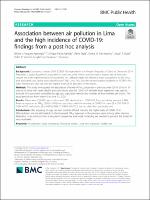Association between air pollution in Lima and the high incidence of COVID-19: findings from a post hoc analysis
Autor(es)
Fecha
2021Colecciones
- Artículo científico [171]
Recurso(s) relacionado(s)
https://bmcpublichealth.biomedcentral.com/articles/10.1186/s12889-021-11232-7Resumen
Background: Coronavirus disease 2019 (COVID-19) originated in the People’s Republic of China in December 2019. Thereafter, a global logarithmic expansion of cases occurred. Some countries have a higher rate of infections despite the early implementation of quarantine. Air pollution might be related to high susceptibility to the virus and associated case fatality rates (deaths/cases*100). Lima, Peru, has the second highest incidence of COVID-19 in Latin America and also has one the highest levels of air pollution in the region. Methods: This study investigated the association of levels of PM2.5 exposure in previous years (2010–2016) in 24 districts of Lima with cases, deaths and case fatality rates for COVID-19. Multiple linear regression was used to evaluate this association controlled by age, sex, population density and number of food markets per district. The study period was from March 6 to June 12, 2020. Results: There were 128,700 cases in Lima and 2382 deaths due to COVID-19. The case fatality rate was 1.93%. Previous exposure to PM2.5 (2010—2016) was associated with the number of COVID-19- cases (β = 0.07; 95% CI: 0.034–0.107) and deaths (β = 0.0014; 95% CI: 0.0006–0.0.0023) but not with the case fatality rate. Conclusions: After adjusting for age, sex and number of food markets, the higher rates of COVID-19 in Metropolitan Lima are attributable to the increased PM2.5 exposure in the previous years, among other reasons. Reduction in air pollution from a long-term perspective and social distancing are needed to prevent the spread of virus outbreaks.
El ítem tiene asociados los siguientes ficheros de licencia:








